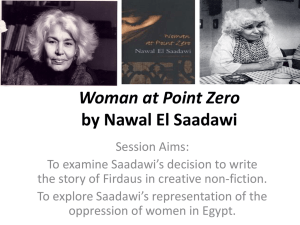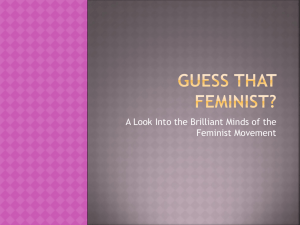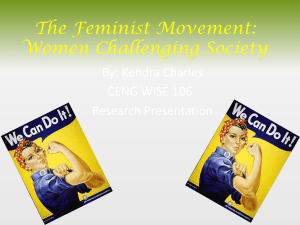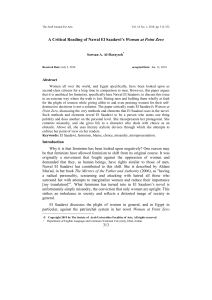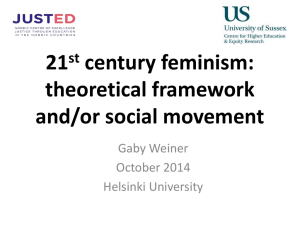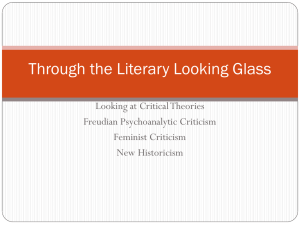Women at Point Zero by Nawal El Saadawi
advertisement
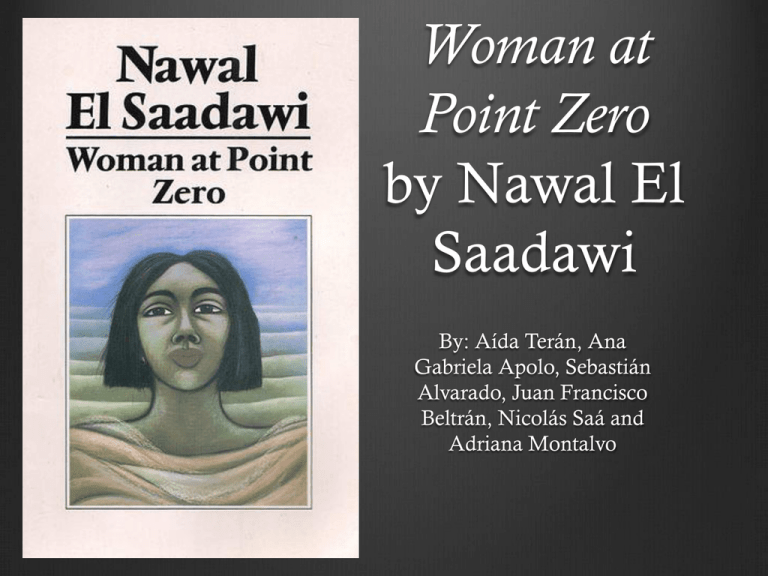
Woman at Point Zero by Nawal El Saadawi By: Aída Terán, Ana Gabriela Apolo, Sebastián Alvarado, Juan Francisco Beltrán, Nicolás Saá and Adriana Montalvo Nawal El Saadawi’s LIFE CONTEXT Historical Context Egypt is located in northern Africa. It is a the place where the Islamic religion was born. In the past, this region was the most prosperous and disputed land. Many wars wreck havoc upon the country which is presentlyu unstable A strong political and religious ideal rule over the whole territory Religion and its effect Islamic religion became an excuse to create social inequality Missunderstanding of the Coran to oppress different groups and justify actions is seen on a daily basis Society is closed minded out of fear and seek refuge in religion and power Work in Egypt In many different countries letting woman work has been a symbol of empowerment and genre equality but not in Egypt In Egypt, women have been given the most degrading jobs and are not considered of value inside the company Most Women do not have the chance to become someone and prove their value Nawal El Saadawi is a Egyptian feminist, sociologist, medic and writer conserning Arab women´s problems. Nawal El Saadawi was born in 1931 in a small village situated outside of Cairo called Kafr Tahla. She was raised in a large family with eight brothers and sisters. El Saadawi described her mom as “a potential revolutionary whose ambition was buried in her marriage”. As a child, Nawal El Saadawi suffered a lot of tough experiences. When she was six years old she had a female circumcision. “When I was six, the daya came along holding a razor, pulled of my clitoris from between my thighs and cut it off ”. Being raised from an Egyptian middle-class family, she was expected to become a child bride, but she refused. “When I was a child it was normal that girls in my village would marry at 10 or 11”. In 1955 she graduated from the University of Cairo Medical School. Her first book, Memoirs of a Women Doctor, was published in 1958 in Cairo. In between 1963 and 1972, El Saadawi worked for the Egyptian government as Director General for Public Health Education. In this period of time, she also studied at Columbia University where she received her Master´s Degree in Public Health. From 1973 to 1978 she worked at the High Insttitute of Literature and Science. During this period of time she wrote the books for which she became famous. Women at Point Zero was published in 1973. In 1981, her critiques towards the Egyptian government, where Anwar Sadat was president, made her be charged for crimes against the state and because of this went to prison for three months. In 1982 she created the Arab Women´s Solidarity Association. In 1993 she went to the US because the received death threats from religious groups. What is the Feminist Theory? Feminism Criticism usually looks at the patriarchal features of a novel or any other cultural representation. The Feminist Theory is normally applied to works of art since these are the ones that usually portray women and men in a way where male dominance predominates. Feminist Criticism from the first and second wave were extremely focused on the representation of women in literature. The Feminist Theory mainly aims to: - Avoid sexism in literature - Raise awareness of the sexual politics represented through language and style. The Novel Through Feminist Lens In order to analyse a book from a Feminist Lens one needs to answer some questions, like the following: - How is the relationship between men and women portrayed? - What are the power relationships between men and women (or characters assuming male/female roles)? - How are male and female roles defined? - What constitutes masculinity and femininity? Applying Feminist Criticism to Woman at Point Zero How is the relationship between men and women portrayed? - The story narrates the life of a prostitute in Egypt, a patriarchal society, therefore women a type of economically dependence towards men is developed. - Firdaus, her mother and uncle’s wife were maltreated by men and sometimes were sexually abused. Thereby women appear submissive with respect to men. How are male and female roles defined? - Female roles are represented within Eastern stereotypes since women are marginalized from the economic, politic and even social world. For example Firdaus dream was to go to school and college, which she was not able to do due to her gender Applying Feminist Criticism to Woman at Point Zero How are male and female roles defined? - Men are represented as powerful people and as the head of the family. In this novel men are the ones who provide to the family, like Firdaus father and uncle, who were the ones who worked. Nevertheless women their wives were not able to enjoy this money as much as men did, since usually men ate the best food etc. What constitutes femininity and masculinity? Masculinity: Show superiority towards women and do not appreciate them as much Femininity: Show sub ordinance in respect to men, keep a women’s problems and complains to herself. Always put a men’s desire should always be in first place. Critical Reception Publication Woman at Point Zero was banned at the time of its publication (1975). Nawal El Saadawi was fired from her position as Egypt’s director of public health after Woman at Point Zero’s publication. She became a political prisoner. Still, her work has been incredibly praised internationally for the analysis and “representations of the sociopolitical oppressions experienced by ‘Arab, Muslim women’” (Weatherston). Reception “The interpretation of Woman at Point Zero and analysis of universal patriarchal oppression is troubling for a number of reasons”(Weatherston). Many critics have pointed out that the novel cannot be simply used as a referential for women’s oppression documentation. Although it does contain similarities between Firdaus and Nawal El Saawadi, she has stated that this is indeed a novel. Therefore, factors such subjectivity should not be ignored. Reception Although Saawadi’s representation of women through the novel can be understood as the representation of all Arab and Islamic women, this would be assuming that “women living under the same cultural conditions share identical experiences of those conditions” (Weatherston), which is not true. For example, Firdaus, her step-aunt, and Sharifa are all women under the same cultural context and they share different experiences. Western Reception It was very rarely to have books translated in english written by Arab women. However El- Saadawi’s books were published in english and they become very recognized. “They argue that she is acclaimed not so much because she champions women's rights, but because she tells western readers what they want to hear.” (Amireh) “The West welcomes her feminist critique of Arab culture because it confirms the existing stereotypes of Arabs and Muslims as backward, mysogynist, and violently oppressive” (Amireh) “We need to encourage a vigorous critical discussion about Arabic literature and culture in the West - one that does not limit itself to the academy. The debate should go beyond 'appreciative' criticism that condescendingly praises Arab women writers for 'daring' to put pen to paper.”(Amireh) Arab Women Criticism Arab women are not happy with the west only knowing ElSaadawi literature because they not represent arab creative writting neither arab society stereotypes. “El- Saadawi writes scientific research which is good. But she writes bad novels and it is unfair that the West thinks that what she writes represents Arab women's creative writing." “I agree that el-Saadawi is popular in the West partly because her works have played into Western prejudices. But I don't think this fact should be merely used to dismiss her achievement.” Works Cited Khaleeli, Homa. "Nawal El Saadawi: Egypt's Radical Feminist." The Guardian. Guardian News and Media, 16 Apr. 2010. Web. 24 Apr. 2014. http://www.theguardian.com/lifeandstyle/2010/apr/15/nawal-el-saadawiegyptian-feminist McBride, Jennifer. "Nawal El Saadawi." Nawal El Saadawi. N.p., n.d. Web. 24 Apr. 2014. <http://www2.webster.edu/~woolflm/saadawi.html>. Amal Amireh. Al Jadid,Vol. 2, No. 10 (August 1996) Rosemary Weatherston. "When Sleeping Dictionaries Awaken: The Re/turn of the Native Woman Informant."N.p., n.d. Web. 24 Feb. 2014. Matko, Kendra. "Woman at Point Zero." Woman at Point Zero. N.p., n.d. Web. 24 Feb. 2014.
